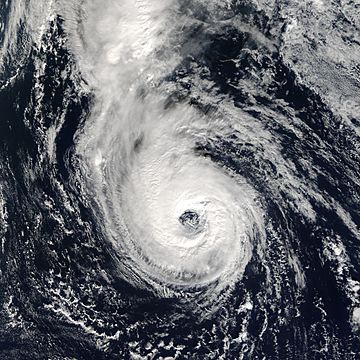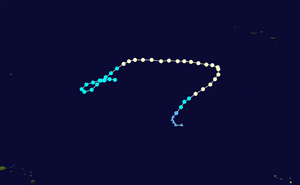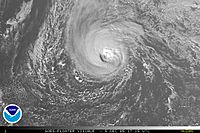Hurricane Epsilon facts for kids
| Category 1 hurricane (SSHWS/NWS) | |

Hurricane Epsilon on December 4, 2005.
|
|
| Formed | November 29, 2005 |
|---|---|
| Dissipated | December 8, 2005 |
| Highest winds | 1-minute sustained: 85 mph (140 km/h) |
| Lowest pressure | 981 mbar (hPa); 28.97 inHg |
| Fatalities | None reported |
| Damage | None |
| Areas affected | No land areas |
| Part of the 2005 Atlantic hurricane season | |
Hurricane Epsilon was a Category 1 hurricane that formed in the central Atlantic Ocean. It lasted for a long time in late November and early December 2005. A Category 1 hurricane has winds between 74 and 95 miles per hour.
Epsilon was special because it was one of the strongest and longest-lasting hurricanes ever seen so late in the year. It was also the 27th tropical or subtropical storm and the 15th hurricane of the 2005 Atlantic hurricane season.
The storm started as a regular low-pressure area that slowly turned into a tropical storm on November 29. It became a hurricane on December 2. This was surprising because the weather conditions were not good for a tropical cyclone to grow. Even so, Epsilon stayed a hurricane for several days. It even confused weather experts at the National Hurricane Center before it finally faded away on December 8.
Contents
How Hurricane Epsilon Formed and Moved
Tropical Storm Epsilon began as an extratropical storm in the middle of the Atlantic Ocean. This happened on November 29. An extratropical storm is a weather system that gets its energy from temperature differences, not from warm ocean waters like a tropical storm. Epsilon slowly gained tropical features, much like Tropical Storm Delta did earlier that year.
At first, Epsilon was far east of Bermuda. It never got close to any land. The storm slowly grew stronger, becoming a powerful tropical storm. Then, on December 1, it weakened a little bit. Weather forecasters at the National Hurricane Center thought Epsilon would get even weaker. They expected it to turn back into an extratropical system.
But Epsilon did something unexpected. On December 2, it got stronger again and became a hurricane. This happened over cooler waters, around 70–75°F (21–24°C). There was also a lot of wind shear, which is when winds blow at different speeds or directions at different heights. These conditions are usually very bad for a tropical cyclone to get stronger.
The forecasters kept predicting that Epsilon would weaken and disappear. But Epsilon did not follow their predictions. It stayed a hurricane for several more days. At one point on December 4, people thought Epsilon had weakened to a tropical storm. But later studies showed that Epsilon had never weakened at all. Hurricane Epsilon then got even stronger. It reached its strongest winds of 85 mph (135 km/h) just a few hours later.
Why Epsilon Confused Forecasters
Hurricane Epsilon really puzzled the forecasters at the National Hurricane Center. It kept getting stronger even when it should have weakened. This made NOAA hurricane expert Dr. Lixion Avila say, "There are no clear reasons — and I am not going to make one up — to explain the recent strengthening of Epsilon…" This meant he truly did not know why the storm was gaining strength.
The storm stayed at hurricane strength for five days. During this time, most of the forecasts said it would weaken below hurricane strength every six hours. Dr. Avila also thought that Epsilon had become an annular hurricane. An annular hurricane has a large, clear eye and a thick, even ring of strong winds around it. This special structure might have helped Epsilon stay strong, even in bad weather conditions.
On December 7, wind shear started to affect Hurricane Epsilon more. The storm began to lose its power. It became a tropical storm the next day. Then, it weakened even more, turning into a tropical depression on December 8. Soon after that, it completely disappeared.
Impact and Records
Hurricane Epsilon stayed far out in the ocean. It never came close to land. Because of this, the National Hurricane Center did not need to send out any warnings. No ships in the ocean reported strong winds from Epsilon. The storm caused no damage and no one was hurt or died.
When Tropical Storm Epsilon formed on November 29, it set a new record. It was the first time that the 27th tropical or subtropical storm had formed in the Atlantic Ocean during one hurricane season. Hurricane Epsilon was also only the sixth Atlantic hurricane ever to form in December.
Epsilon spent more time as a hurricane during December than any other Atlantic storm. This broke the old record that was held by Hurricane Lili in 1984.
Related pages



